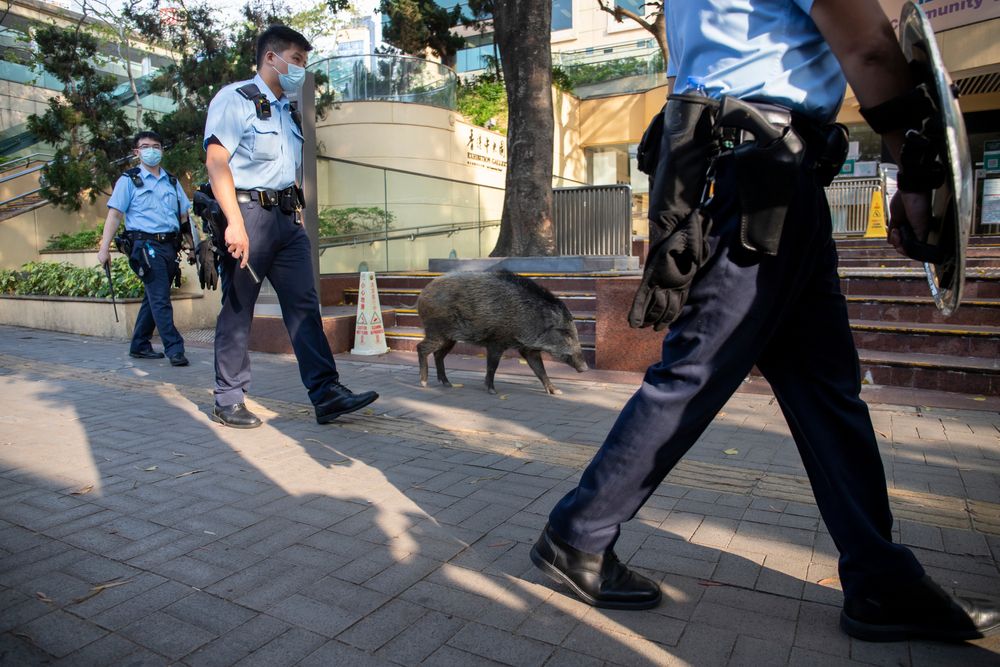Covid-19 has highlighted concerns about the public-health risk from wildlife through the transmission of disease-causing pathogens. Yuen-ying Chan and Jasmine Wang of The University of Hong Kong look at how the proliferation of wild boar in Hong Kong, mainland China and elsewhere around the world is prompting policies to control them and head off a potentially major threat to humans.
Public nuisance – and public-health threat?: Hong Kong police escort an errant pig (Credit: Yung Chi Wai Derek / Shutterstock.com)
Year-end 2021 is a time of reckoning for wild boars in Hong Kong and mainland China, where both governments have reversed longstanding policies of accommodation towards the mammal. Now, orders have been issued that the boars must be managed, controlled and be killed if necessary.
The new policies are another signal of the rising tension between humans and wildlife as they intrude into each other's habitat in a world of diminishing natural resources. The tension is accentuated by the pandemic as scientists seek to understand the zoonotic origin of Covid-19 and the likelihood that the disease has been transmitted via viruses that jumped from animals to humans. For more than a decade, researchers have warned that wild boars are carriers of viral, bacterial, and parasitic diseases that can affect livestock, wildlife – and humans.
But traditions die hard. Many cultures, East and West, value the porcine as a delicacy for their nutty flavors and lean meat. In less developed areas, wildlife such as boars are valued as a rich source of protein. For some environmentalists and nature lovers, wild pigs are an exemplar of biological diversity that should be cherished and preserved.
New porcine policies in mainland China and Hong Kong
Hong Kong and mainland China are taking strong measures to reorient the relations between the boars and humans.
In spite of angry protests from some members of the public, who charged the government with cruelty, officials are standing their ground. In one high profile action, seven boars were lured to a public street with bread crumbs and captured to be killed later by injection.
Across the border in mainland China, wild boars will be hunted down after expected adoption of a proposal by the National Forestry and Grassland Administration to remove them from the list of protected wild animals. Across the country, 117 hunting teams have been set up, ready to move on the pigs, according to the proposed plan released in early December. Previously, the boars were included in the roster of 1,789 protected land mammals that are considered to be beneficial to ecology, science and society.
The policy changes could signal the end of two of the last official refuges of feral hogs, as governments around the world cope with their intrusion into the human environment with rising alarm. Wild swine have become an issue in cities all over, from Barcelona to Brisbane, from Haifa to Houston.
Concern for infectious diseases
For scientists, the crackdown on wild boars is a policy that should have been implemented a long time ago.
Since 2003, infectious respiratory virus caused pandemics such as the severe acute respiratory syndrome (SARS), the Middle East respiratory syndrome (MERS), and Covid-19 have wreaked havoc on human society. Both the SARS and MERS viruses originated from bats, according to scientists who have traced their origins. Researchers have shown that bats are warm-blooded mammals with a genome very similar to that of humans. Bats living in the wild carry a large number of pathogens that can be transmitted to humans after mutation.
Genetically, wild boars are more similar to humans than bats. They are also warm-blooded mammals and have a comparable physiology. If wild boars breed in large numbers and frequently enter the human living environment, the pathogens in them could pose a potential major threat to human health.
The most well-known infectious organism transmitted by wild boars is the hepatitis E virus (HEV), a lesser-known hepatitis virus, which has been spreading worldwide. HEV has four different genome types. Domestic pigs and wild boars are the main host animals for HEV genome type 3 and type 4, which have in recent years been most frequently responsible for expanding infections by the virus in developed countries. Both HEV genome type 3 and 4 have a wider transmission pathway, which can be transmitted through the consumption of HEV-infected animal products (mainly domestic pork and wild boar meat), as well as direct contact with the undercooked meat and blood products of infected animals.
Seeking accommodation
These scientific findings have given mankind ample warnings about the danger of wild boars multiplying into the environment. They could damage not only property but also human life. The potential threat to human health caused by the pathogens carried by wild boars cannot be ignored.
Governments must do more, while scientists must reach out to share their findings with the public. Advocacy for wildlife and diversity must be based on knowledge and evidence-based arguments. Public policies must also be holistic and targeted with precision. The Chinese government, for example, has stopped short of banning, or at least seriously restricting, the consumption of meat from wild boars. Unlike some other jurisdictions, the Chinese government still has to create protocols for their hunting. In Hong Kong, the government needs to step up enforcement of the ban against feeding wild boars and increase the fine for those who break the law.
It is time for governments, scientists and NGOs, including animal welfare groups, to get together to find ways to restore the balance among humans, wildlife and nature.
Further reading:
Yuen-ying Chan
Journalist, author and media consultant
Jasmine Wang Yixin
The University of Hong Kong
Check out here for more research and analysis from Asian perspectives.




